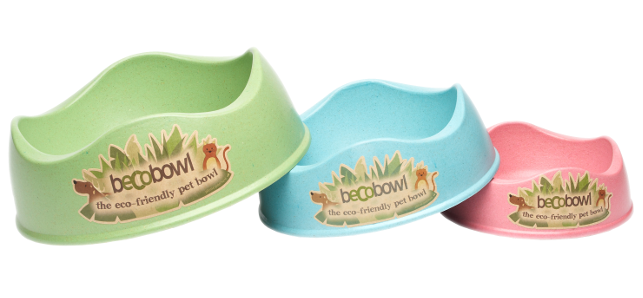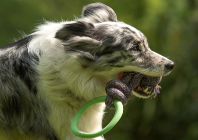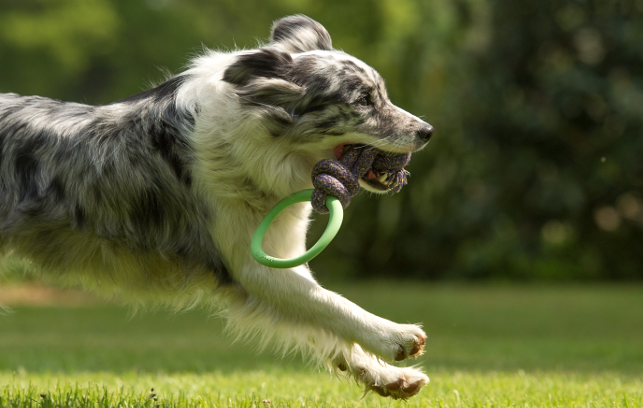
Providing a dog with endless hours of fun, the Beco Ball on Rope is made from natural rubber and cotton
You’re creating a product for a user whose mission, from when it wakes up in the morning, is to destroy your product,” offers Toby Massey, co-founder of Beco Pets. “That’s what most of my customers do.”
It’s not a mission statement most designers have to adhere to, yet in the world of dog toys it’s the challenge that faces a pet products company.
Beco’s designs walk a fine line between fulfilling the dog’s needs and attracting the attention of an owner that first has to buy the product, all the while holding up some serious eco credentials.
“That came first. Our Beco bowls were our first products with the idea of using offcuts of bamboo and rice husks,” says Massey.
Having left university, Massey challenged himself with finding a commercially viable market into which to launch a product that could be made from materials recycled from mass manufacturing’s waste.
“Dog bowls: you’re not producing them like toothbrushes, where they’re turned out in the millions and millions. You can produce 500, or a thousand dog bowls, and make a profit,” he explains of his brainwave.
“When you’re starting up a company it’s quite a challenge to find that niche, and just because it’s eco-friendly doesn’t mean it’s £25 for a dog bowl – it’s a fiver – and everyone can afford a fiver for a nice dog bowl.”
Set tails wagging
Over its nine year history, of which a stint was also spent designing baby toys, the range of Beco products has expanded to include chew toys, throwing ropes, soft play animals, and even poo-bags. Everything it produces demonstrates an eye for detail and a deeply ingrained concern for the wellbeing of pet, owner and environment.
A lot of this arises from the experience of dealing with the requirements for launching a toy or product for a child – mountains of testing certifications, legislation and other standards the product had to meet.
“There’s none of that in the pet industry at all!” exclaims Massey, readily pointing out that the pet industry is also a shocking four times the size of the equivalent baby products business.
“It does help differentiate us. We’re able to speak with a lot more confidence about what materials are in our products – we have a lot more due diligence on what the materials supply chain is like.”
The entire process is overseen from Beco’s headquarters in South London, where the majority of its design team work in an office perched above its distribution warehouse.
A full operation is also maintained in China, where the production and distribution arm of Beco is taken care of. As Massey explains, the business plan is straightforward: “Use the waste materials at source, produce [products] and ship them to all our customers around the world.”
Left-overs from chopstick factories and leftover rice husks from food production centres locally in Asia are recycled and mixed with natural rubber, before being used to produce the product out there, before being shipped to the rest of the world where dogs can play with them, with the additional eco benefits of a reasonably low carbon footprint.

DEVELOP3D’s resident hound — Mycroft Holmes — with his toy bone, which is tough, extra bouncy and made from natural rubber and rice husk
Design for dogs
The design of the products is a fine balance, given that the main consumer – the dog – gets the fun, while the owner is more typically focussed on the way it’s styled.
With this in mind, the design process typically begins with the search for a market sector that has potential.
“Sometimes I have a good idea moment when I’m out with my dog, and that starts off a chain,” says Massey, “But generally it’s looking for needs… that’s the commercial side of what we’re trying to do: we’re looking for something that we think will be commercially viable right from the beginning.”
This method gives the team a set of guidelines to work within. Sketches are shared with dog owners and retail outlets to work up solid concepts, which progress swiftly to 3D modelling and producing prototypes – rubber toys from moulds or stitched fabric.
The development from this point is solely about testing with animals, how they’ll react, play and set out to break them.
“When you‘ve got a very expensive rapid prototype that you’re going to give to a dog and watch them destroy… that’s a bit depressing, but at the same time you have to do it to see how a dog can interact with the toy and get the pleasure out of it.”
While flexing a signature green Beco Bone, Massey explains the challenge for chew toys is to make them as pleasurable as possible, from a material that is inherently uninteresting to the dog: a block of rubber.
Here is where the crossover with baby products returns – bright colours, interesting shapes, and how the toys bounce and roll and move are all important. Additionally, for dogs it’s all about textures felt with their mouths.
“Testing with animals is completely different to testing with humans,” laughs Massey.
“You can give it to any number of dogs, and then give it to another dog and you’re left thinking ‘how the hell has that dog managed to do that to it?!’.”
Physical testing can also solve many problems that initially had not been thought of.
The shore hardness – determined by the mix of recycled rice husks and rubber – is an important factor.
Softer materials are weaker in a standard strength test, but prove longer lasting in the real world due to how the dog gets enjoyment. When the dog bites it, the fl ex of the rubber is what it enjoys. Bones that are really solid and rigid are broken far too quickly for that reason.
So instead of ripping it to shreds, the right amount of flex helps keep the pooch interested for longer.

The Beco bowls were the company’s fi rst products born from the idea of using offcuts of bamboo and rice husks
New tricks
“The precision engineering needed in making a dog bone is not at the same level needed to make a 200mph wheel holding a car to the road,” smiles Massey, yet, he explains, at the same time it needs to be designed in a way that’s engineered precisely enough to produce thousands of pieces as quickly as possible; doesn’t break the tools, and can be produced for the right price.
“In my mind it’s all about real world design, what we’re trying to do is use our design understanding and knowledge and make things as effi cient, as cost effective and as great for a business as we can, while having as little impact on the environment as we possibly can.”
Unlike most mass-produced pet toys, Beco’s have a full lifecycle plan – from recycled beginnings, the toys are biodegradable once in landfi ll, and much safer than many mass-produced plastics should the dog manage to consume any of it by accident.
As Massey asserts, this attention to design as part of its wider business planning is what has seen the company grow, distributing Beco products to 40 countries worldwide.
“The reason why we’re quite successful, I think, is I still believe that people like the idea – anywhere in the world – of buying products that have had some consideration and thought put into how it’s been designed and produced.”
Next is Beco’s entry into the pet food market, and tackling the non-recyclable metallised plastic bags that most come in, as well as the huge carbon footprints many ingredients bring.
Beco has spent a lot of time and cost working with a packaging company on a fully compostable design – glue, seal, inner, even a stay-fresh zipper – to house its own, produced local-to-market, food.
The dedication to being eco-friendly is fortified throughout the company, even down to warehouse staff, who collect used cardboard from neighbouring companies then shred it to form the packing for its order boxes.
Yet, for all its work highlighting what can be done with the by-products of mass manufacturing, the success of the products is down to those with four paws.
Having returned from our visit with some Beco goodies for Mycroft, DEVELOP3D’s [sometimes] faithful office hound, it’s fair to say he has done nothing since but work passionately at destroying them – in the best possible way.
Beco provides pet products with eco credentials
Default






